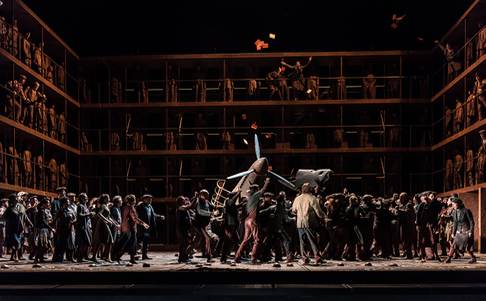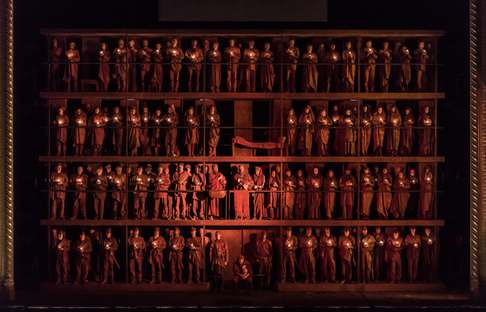Oedipe had a long gestation – partly because the composer’s draft manuscripts were lost when they were sent to Moscow in a consignment of crates during the German offensive in Romania in 1917. Inspired by a performance at the ComÈdie FranÁaise in 1909 of Oedipus Tyrannus, by 1922 the opera’s vocal score was prepared; the finishing touches had been applied by 1931, and the opera reached the Paris OpÈra stage in March 1936.
Librettist Edmond Fleg ignored the theatrical experimentations of his day – expressionism, constructivism, symbolism – and told the story straight. He also disregarded Aristotelian unities of time, place and action, and traced the eponymous hero’s life from birth to death in the manner of a Victorian Bildungsroman, drawing on both Oedipus Tyrannus and Oedipus at Colonus – and also responding to inferences in Homer and Seneca – to re-construct the pre-history of Sophocles’ play. The libretto also emphasizes the parallels between the Greek myth and Christianity – the story of Abraham and Isaac, the Nativity, the Flight into Egypt: Fleg’s Oedipus is both universal and Messianic.
Fleg had originally envisaged a Ring-like drama spread over two evenings but Enescu advised, ‘do what the best chefs do. Put it back on the stove and let it reduce’. There are six scenes grouped into four Acts. The first serves as a Prologue in which we learn of the birth of Oedipus and TirÈsias’s prophecy that the child will kill his father, King LaÔos of Thebes, and marry his mother, Queen Jocaste. Terrified, the monarchs order the Shepherd to take the baby to the Cithaeron Gorge where he will die of exposure, but the Shepherd gives the child to Phorbas who in turn exchanges him with the dead son of King Polybos and Queen MÈrope of Corinth. The final Act is an Epilogue in which we see the aged king, attended in his last days by the faithful Antigone. These outer Acts frame the tragic drama.
Now a young man, when leaving Corinth Oedipus hears of his destiny; an angry encounter with LaÔos results in the latter’s death. Oedipus then becomes a hero to the Thebans when, solving the Sphinx’s riddle, he saves them from its murderous clutches; in reward they offer him their kingdom, and the widowed Jocaste as a bride. Twenty years pass and Thebes is struck by a terrible plague which the Oracle declares will continue until LaÔos’s assassin is punished. When TirÈsias reveals the truth of Oedipus’s identity, the king confesses his guilt, blinds himself in atonement and leaves Thebes, accompanied by his daughter, Antigone.
 Production by ¿lex OllÈ (La Fura Dels Baus) and Valentina Carrasco with set designer Alfons Flores and costume designer Lluc Castells
Production by ¿lex OllÈ (La Fura Dels Baus) and Valentina Carrasco with set designer Alfons Flores and costume designer Lluc Castells
This production interweaves the timelessness of the myth with historical specificity, the latter in effect underpinning the former. Alfons Flores’s designs evoke both the cultural glories of the classical past – tiered galleries and statuary – and the destruction and disasters, manmade and natural, of the modern age. Baroque archways are juxtaposed with WWII fighter planes; the ubiquitous clay-coloured palette suggests both ancient pottery and a world ravaged by toxic devastation. In fact, OllÈ explains that this visual scheme was inspired by a catastrophic chemical spill in 2010 which saw one million cubic meters of corrosive waste dumped on western Hungary: ‘that mud […] in our minds was also linked with the myth of man’s creation from primeval clay [and] symbolizes the plague that devastates Thebes, and is also the means by which the contagion spreads’.
Lluc Castells’s costumes reference contemporary combat fatigues while Peter van Praet’s lighting design keeps the world in shadow. Indeed, one might be forgiven for deducing that the opera’s message is, ‘we all live in a twilight zone’. The murkiness also obscures some of the set’s copious detail, and the unalleviated gloom is a bit wearying, although it does make the coup de theatre of the closing moments all the more powerful.
 Production by ¿lex OllÈ (La Fura Dels Baus) and Valentina Carrasco with lighting design by Peter van Praet
Production by ¿lex OllÈ (La Fura Dels Baus) and Valentina Carrasco with lighting design by Peter van Praet
In fact, the production opens with a striking theatrical moment too, when the motionless terracotta statues that populate the four-tiered edifice ‘come to life’, and reveal themselves to be the principals and expanded chorus, the people who bear witness to Oedipus’s tragedy. Such imposing effects conjure the epic grandeur of classical tragedy, but they also run the risk of impeding the dramatic momentum and turning the opera into a series of static tableau. And, while Enescu takes a very different path to that explored by Stravinsky in Oedipus Rex (1926-27 rev. 1948) – the austerity and Latin text of which establish a distance between the audience and the action – OllÈ’s immobile figures brought to mind Stravinsky’s instruction that his opera-oratorio should be staged with minimal movement and the principal singers masked.
During the central two Acts, the tension is successfully built, as TirÈsias’s prophetic assertions are confirmed one by one; but the early events are presented as stage-pictures and we have to wait until Oedipus’s confrontation with the Sphinx in Act 2 for the drama to take off. Interestingly, this is the point in the libretto where Fleg reveals his Oedipus to be not a tragic victim of higher powers but a modern man, a master of his own destiny.
Sophocles’s riddle had presented a summary of the three stages of human life: ‘What creature is it that moves on four legs in the morning, two legs at noon, and three legs in the evening?’ The answer is man, who crawls, then walks, then leans fragilely upon a cane in old age. Fleg changes the Sphinx’s question, ‘Name someone or something that is greater than Fate?’, but the answer is the same: ‘Man! Man alone is more powerful than Fate!’
Her sobs interspersed with cackles, the Sphinx begins to go mad, crying, ‘Only the future will tell whether the Sphinx, as she dies, was weeping at her defeat or laughing in her victory.’ OllÈ and Flores heighten this moment by introducing a diving Spitfire plane – an elegant killing-machine – whose wings become those of the Sphinx. The fateful encounter with LaÔos – a mad moment of road-rage – is blindingly intense and boosts the dramatic impetus.
Enescu’s Oedipe is a proto-Siegfried, a larger-than-life individual who faces extremities and fatal choices, and the demands placed upon the singer who takes on the marathon role are considerable. The Danish bass-baritone Johan Reuter had the power to sustain the crests, singing with pliant, muscular force and clarity. Perhaps the tone colour was rather monochrome but this was still a deeply moving portrayal which conveyed the king’s rage and suffering – Reuter emitted a horrific scream when the truth of TirÈsias’s revelation became clear to him – but also convinced us of Oedipus’s ultimate serenity in death.
It is almost a one-man-show, with the other characters somewhat eclipsed; but, the other principal roles were impressively defined and well-delivered.
Marie-Nicole Lemieux was terrifically unnerving as the Sphynx, letting rip a fearful Sphrechgesang howl as she died to an iridescent glissando on musical saw. Indeed, the uncanny orchestration and microtonal nuances formed an aural ‘nightmare’, but and it is a credit to Lemieux that the Sphynx’s so evident agonies won the sympathy of the audience. Stefan Kocan’s contribution to this scene, as the sombre Watchman, was also commanding.
Sarah Connolly was stylish and charismatic as Jocaste, using all the sumptuousness of her mezzo to reveal the Queen’s tragic suffering, while Sophie Bevan injected some welcome sweetness and delicacy as Antigone. Sigmund Freud may have given us the Oedipus Complex in The Interpretation of Dreams (1900), a label for our anxieties about self-knowledge and identity, but it seemed a little unsubtle to place Oedipus on a psychiatrist’s couch during his scene with MÈrope, though contralto Claudia Huckle sang the role with richness.
As the King of Athens, ThÈsÈe, Jette Parker Young Artist Samuel Dale Johnson revealed a lyrical baritone. French bass Nicholas Courjal was a sonorous High Priest, and the role of Phorbas was delivered with dignified composure by Korean bass In Sung Sim. Sir John Tomlinson uttered TirÈsias’s two pronouncements with characteristic thunderous resonance.
The score of Oedipe is an amalgam of eclectic influences fused into a suave Romantic idiom in which Wagnerian leitmotiv and Straussian expressionism sit alongside a Debussy-ian melodism (the composer’s flair for setting the French language is one of the opera’s glories), and folk motifs reminiscent of Kod·ly are juxtaposed with quarter-tone colourings as in the agonised folksong when Oedipus approaches Thebes. There is both lushness – as in the quasi-Brahmsian richness of the joyous celebration of the hero’s birth and the triumphal response to the deliverance of Thebes after Sphinx’s demise – and sparseness, when the orchestration is pared down to a single woodwind instrument accompanying a poetic declamation.
Conductor Leo Hussain brought forth the vividness of Enescu’s orchestration but noted too its refinements, every colour and tone. The ROH Orchestra, and the Chorus – serving as Theban citizens, shepherds, the King’s bodyguard, and aged Athenians – rose magnificently to the challenges.
Enescu elevates Oedipus to almost God-like heights and in the Epilogue OllÈ and Carrasco confirm his status as an existential hero, full of defiance and contempt for those forces that would destroy him. His final words, ‘I am innocent, innocent, innocent!’ My will never accorded with my crimes. I triumphed over Fate!’, convey a heroic resistance to oppression and it is not hard to imagine librettist and composer, writing in the aftermath of WW1 and as Romania found itself terrorised by a succession of dictatorial regimes, empathizing with their protagonist.
This production, in its stunning closing image allows Oedipus to transcend from the darkness of blindness to the clarity of celestial light: the directors present a radiant apotheosis as Oedipus walks into the light and regains his sight in death. The words of Sophocles’s Chorus seem apposite: ‘Citizens, listen to me: never glance away from your final day of life. Regard no man as happy until he has passed the boundary stone of death and has suffered no harm.’
Claire Seymour
Casts and production information:
Oedipe: Johan Reuter; TirÈsias: John Tomlinson; Antigone: Sophie Bevan; MÈrope: Claudia Huckle; Jocaste: Sarah Connolly; The Sphinx: Marie-Nicole Lemieux; A Shepherd: Alan Oke; The Theban High Priest: Nicolas Courjal; LaÔos: Hubert Francis; CrÈon: Samuel Youn; The Watchman: Stefan Kocan; ThÈsÈe: Samuel Dale Johnson; Theban Woman: Lauren Fagan. Chorus and Orchestra of the Royal Opera House, Covent Garden. Conductor: Leo Hussain; Stage directors: ¿lex OllÈ (La Fura Dels Baus) and Valentina Carrasco; Set Designer: Alfons Flores; Costume designer: Lluc Castells; Lighting designer: Peter van Praet. Monday, 23 May 2016, Royal Opera House, Covent Garden, London.
image=http://www.operatoday.com/Oedipe_ROH1.png
product=yes
product_title=Oedipe at Covent Garden
product_by=A review by Claire Seymour
product_id=Above: Johan Reuter as Oedipus [All photos copyright Clive Barda, courtesy of Royal Opera House, Covent Garden]